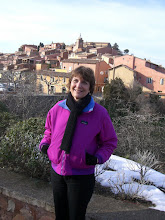Not surprisingly, the happiest moments of our trip had to do with meeting people. We were so excited to be reunited with our kind and generous friends in Malaucène and Montpellier who had us over for meals at their house. Then there were new folks like Jeannette, the owner of the boucherie, who was quite chatty and probably the first of many to congratulate us on the election of Obama. We’ll recall the couple in a restaurant in Lyon who discussed Asian food and also had a lot of positive things to say about our new American president. There was the Parisian couple in Saint Tropez who loved talking about food and wine and told us about some lovely sights to visit in the coastal city. Who could forget the heavy-set restaurant owner/biker in Ajaccio whose collection of tiny motorcycles lined the walls of one of his dining rooms? Or the director of the tram system in Montpellier who discussed French politics with us in Paris? Too many memories to mention, really, with warm, friendly French people.
The highlight of our trip, though, was thanks to people we encountered at the end of our visit to Paris, just days before flying home. On that Saturday we first ran into some Maghrébins (Algerians, to
 be specific), a young married couple named Ben and Zahia, who happened to be standing in front of us in line to get ice cream. We sat next to them while eating our cones and started talking. Afterwards, they invited us to continue our conversation while having thé à la menthe (“mint tea”) at their friend’s café. We discussed many things with them: why North Africans pour while moving the pot up and down; the history of the Berbers and their language; the upcoming birth of their first child. They were truly a delight.
be specific), a young married couple named Ben and Zahia, who happened to be standing in front of us in line to get ice cream. We sat next to them while eating our cones and started talking. Afterwards, they invited us to continue our conversation while having thé à la menthe (“mint tea”) at their friend’s café. We discussed many things with them: why North Africans pour while moving the pot up and down; the history of the Berbers and their language; the upcoming birth of their first child. They were truly a delight.
Later on that same day, we were enjoying probably the best dinner of our trip at a very small restaurant in the 14e called l’Entêtée when a man and his daughter took the table right next to ours. The limited space (in this case a good thing!) practically forced us to talk to them. Again, the topics varied widely and eventually they invited us to come to their house after the meal for coffee. Which we did. When my husband asked them where he could get good boudin (“blood sausage”) in the city, they asked us to come back to their place for lunch on Sunday! It was such a surprising and generous offer. We took them up on it and thoroughly enjoyed ourselves!

Now that I am back home, I won't be blogging on a regular basis anymore, but I'd like to take the opportunity to thank my readers. Please feel free to use the comment button on the blog to communicate with me. So, for now I'll say, « au revoir »--“till we meet again.”








